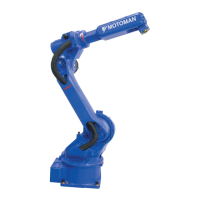Appendix A
A.1 MLX200 Add-on Instructions
A-12
168542-1CD
168542-1CD
MLX200 Software and
Operations
A.1.10 MLxRobotMoveLinearAbsolute
The MLxRobotMoveLinearAbsolute instruction is used to initiate a Linear
motion of the robot TCP in Cartesian space to an absolute target position.
The result is a straight line trajectory for the robot TCP. The user can
specify the target position as well as desired speed, accel/decel, and jerk
parameters (when using a Jerk-Limited Velocity Profile). These
parameters can be specified as either absolute values (e.g. 750 mm/sec)
or a percentage of the max speed (e.g. 50%). The max translational and
rotational speeds can be found in the MLX[].Robot[]. ConfigurationData
data structure.
Fig. A-10: MLxRobotMoveLinearAbsolute Instruction
Table A-10: MLxRobotMoveLinearAbsolute Instruction
Name Data Type Usage Description
RobotNumber DINT Input The robot commanded by this instruction
instance. Valid values are 0 to
MLX[].NumberOfRobots-1.
TargetPosition MLxAppData TeachPoint InOut MLxAppDataTeachPoint containing the target
position. This position can be taught from the
{Teach} Screen using the MLX200 HMI
TargetType Bool Input Axis/TCP Position. 0= Axis Position 1= TCP
Position. This will define which data inside the
TeachPoint structure to use. In most cases,
these values will be the same and lead to the
same motion. However, if the data inside the
TeachPoint has been modified manually, this
parameter can be used to point to the new data.
BlendFactor DINT Input Valid values: 0-8. This will define how much this
motion should be blended into the next motion.
Note: an additional motion will need to be added
to the queue for this parameter to work correctly.
See User Guide for detailed instructions on
using this parameter.
Speed REAL Input Speed to move axis in % of maximum.
UseRotationalSpeed BOOL Input Units to use for Speed. 0 = (linear units)/sec, 1=
deg/sec. When set to 1, the speed of a linear
motion between two points is defined as the
time is takes to rotate the product at the defined
rotational speed. The rotation and linear
translation will stop at the same time.

